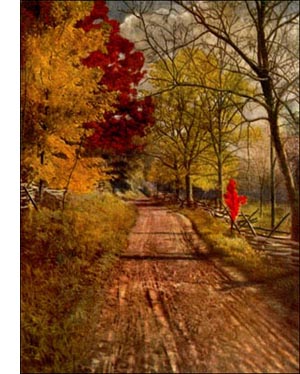Burning Bush
 FAMILY CELASTRACEAE
FAMILY CELASTRACEAEEvonymus atropurpureus, Jacq.-This dainty little American tree skirts the edges of deep woods from western New York to Montana, and south to Florida and Arkansas. The foliage is not noticeable, and the tree might be mistaken for a wild plum, except for its fluted ash-grey bark.
The close observer will see that the leaves are opposite. The flowers in their axillary clusters spread flat their four purple petals to support a square platform that bears the stamens and pistils. They are succeeded by equally strange-looking fruits. Four flattish lobes, deeply separated, turn to pale purple as they reach full size. The whole fruit is one-half inch across in October.
The purple husk parts and reveals the seed, enveloped in a scarlet outer coat that fits it loosely. The delicate pale lining of the purple envelope makes harmony between the two stronger colours, and the plum-coloured twigs and yellow leaves contribute to make this indeed a burning bush, that glows brighter as the advancing winter opens all the husks and displays the scarlet seeds.
No brighter dash of colour can be added to gardens or shrubbery borders than this tree, which shows its beauty chiefly in the dead of winter. It does not require botanical knowledge to recognise that the climbing false bittersweet, Celastrus scandens, is a very near relative.
The European Evonymus is called spindle tree, for its wood has long been used in making spindles, knitting needles, and other small articles requiring hard, close-textured wood. Toothpicks and skewers are made of it, and the English often call the tree prickwood for this reason.
Our species is locally known as the wahoo. Chinese and Japanese species are now planted in American gardens, both tree forms and some notably valuable shrubbery and climbing species. Two other members of the same family are found in America.
Gyminda Grisebachii, Sarg., is a relative of the wahoo which grows on the islands of southern Florida. Its wood is hard and black. The small white flowers are succeeded by blue berries.
Yellow Wood or Florida Boxwood Tree